RadRover full fenders installation guide
The RadRover Fenders are compatible with the 2018 and 2019 model year RadRover.
The installation process is a little different depending on the model year. Watch this video and read the instructions below to learn how to install fenders on a 2018 or 2019 RadRover.
The RadRover 5 and RadRover Step-Thru 1, both of which will be released in early 2020, will come with front and rear fenders, and the rear fender will be pre-installed. If you have one of those RadRover models, consult your Owner's Manual for instructions on front fender installation.
RadRover fender kits include:
- The front fender with the mounting bracket installed,
- The rear fender with the 2019 mounting bracket installed,
- The 2018 rear fender mounting bracket (for 2018),
- A (taller) taillight mount (for 2019), and
- A bag of hardware including:
- (1x) Headlight bolt - optional replacement (Headlight mounting bolt, if necessary)
- (2x) 40 mm long bolts (Rear fender: one for chainstay, one for seatstay)
- (2x) 26 mm long bolts (Front fender P-clamp bolts)
- (2x) 23 mm long bolts - optional replacement (Rear fender mounting bracket, if necessary)
- (2x) Smaller washers (Front fender P-clamp on 26 mm bolts)
- (4x) Larger washers (Two for each 40 mm chainstay and seatstay bolts)
Tools needed:
- 4 mm Allen wrench,
- 5 mm Allen wrench,
- 10 mm wrench,
- 18 mm wrench,
- 8 mm wrench (for 2019),
- Torque wrench with 4 mm and 5 mm Allen bits, and an 18 mm wrench bit,
- Flat side cutters (for rear wheel removal option), and
- A replacement zip tie (for rear wheel removal option).
2018 and 2019 RadRover Front Fender Installation Steps:
- Shift the bike into gear 7, which will make several steps easier (by moving the chain onto the smallest cog of the freewheel).

- Power off the bike. Ensure the bike is in the off position and use the key to remove the battery. Once removed, press and hold the “MODE” button on the LCD Display Remote until the display remains off for about two seconds (it may flash on briefly). This ensures the power is fully discharged from the bike and it is safe to work on.
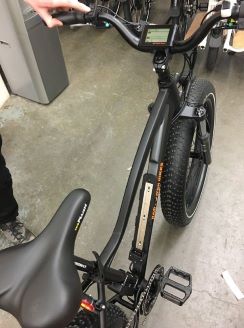
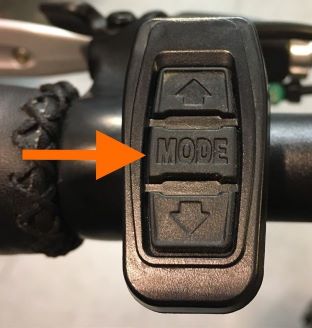
- Install the front fender, which is shorter than the rear fender:
- Remove the headlight. Unplug the headlight connector by pulling each side of the connector directly apart. Use a 5 mm Allen wrench and a 10 mm wrench to remove the headlight bolt, front washer, rear washer, and lock nut. Set this hardware aside for reinstalling the headlight.
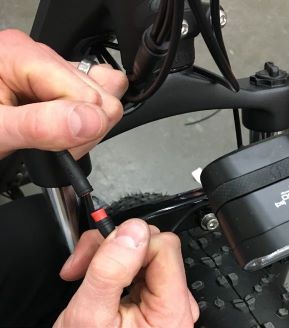
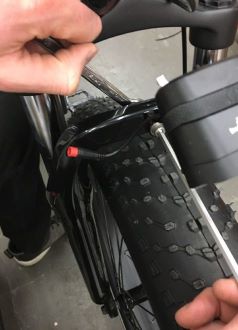
- Move the fender into position. Deflate the tire enough to pass the U-shaped metal bracket under the front fork arch. From the back of the front wheel, pass the front of the fender between the tire and the front fork arch so the U-shaped bracket is just in front of the light mount on the fork arch.
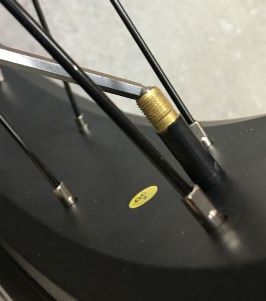
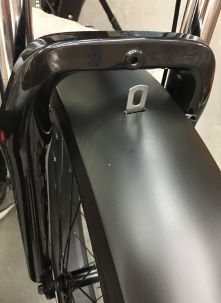
- Bolt the fender and headlight to the front fork arch. Pass the headlight bolt through one washer, the headlight mount, the U-shaped metal bracket on the fender, and into the mounting point on the front fork arch. On the back of the bolt, install a washer and then the locknut. Use a 10 mm wrench and 5 mm Allen wrench and torque to 6 Nm. Then connect the headlight by carefully aligning the pins inside and arrows on the housing and pressing the ends together to fully seat the headlight connection.
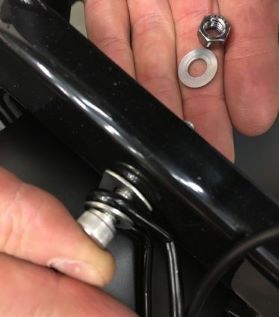
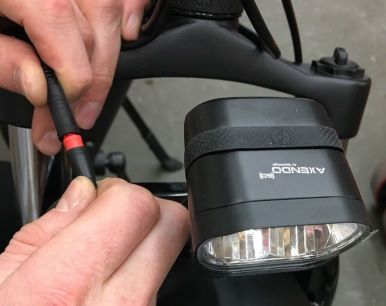
- Move the P-clamp mounting brackets into position on the suspension fork lowers. On the left side of the front wheel, the side with the front brake, take care to not touch the metal brake disc and wrap the P-clamp around the fork lower (below, left). Ensure the mounting bracket runs along the outside of the brake cable. Wrap the right side P-clamp around the fork lower (below, right).
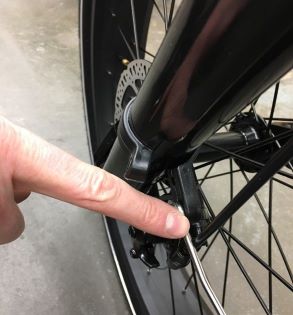
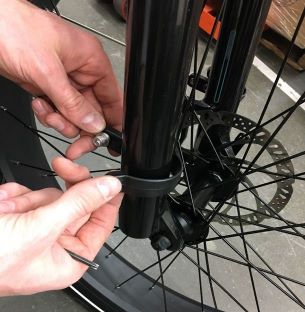
- Tighten the P-clamp leaving a gap to ensure both sides are parallel. Insert one 26 mm bolt into one small washer, through the P-clamp end, and thread into the backing nut. Tighten until the gap between the P-clamp end and the side is parallel (as indicated by the orange lines below). Do not overtighten. Repeat on the other side.
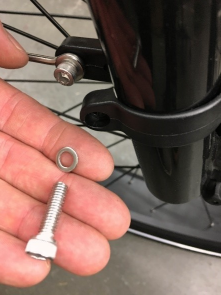
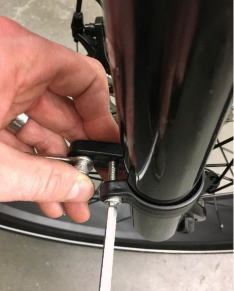
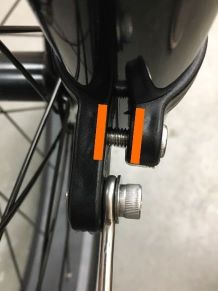
Right side front fender clamp photos are above, left side photos are below.
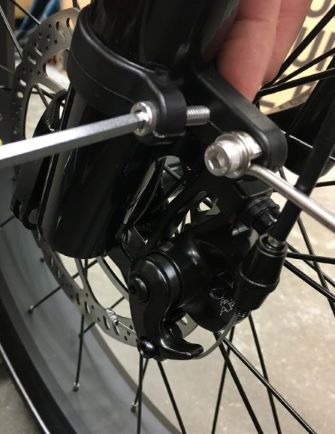
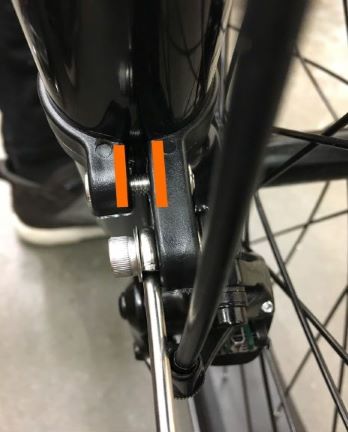
- Remove the headlight. Unplug the headlight connector by pulling each side of the connector directly apart. Use a 5 mm Allen wrench and a 10 mm wrench to remove the headlight bolt, front washer, rear washer, and lock nut. Set this hardware aside for reinstalling the headlight.
- Identify the model year of the bike (2018 or 2019). The 2018 RadRover (below, left) has “radpowerbikes.com” printed on the seatstay, while the 2019 RadRover (below, right) has three parallel orange lines painted on the seatstay. Contact Rad Power Bikes if you need assistance identifying the model year of the bike.
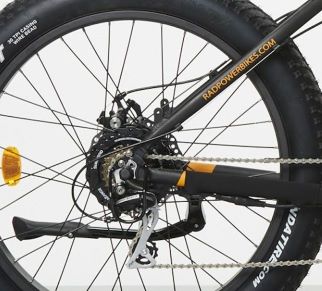
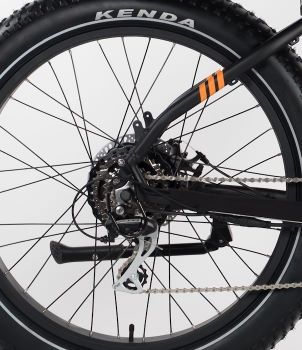
- Install the rear fender per the steps unique to the bike model year by clicking on the bike model steps below. There are a few differences in RadRover rear fender installation between the 2018 and 2019 models.
2018 RadRover Rear Fender Installation Steps:
- The rear fender ships with the 2019 mounting bracket installed. Before attaching the fender, swap out the metal mounting bracket attached to the rear fender (2019) with the mounting bracket included in the box (2018):
- Remove the 2019 mounting bracket from the fender. Use a 4 mm Allen wrench to remove the two bolts holding together the mounting bracket clamp (consisting of an exterior metal piece and a threaded backing plate on the fender’s interior). Remove the 2019 bracket and recycle where possible. Set the hardware aside for re-installation.
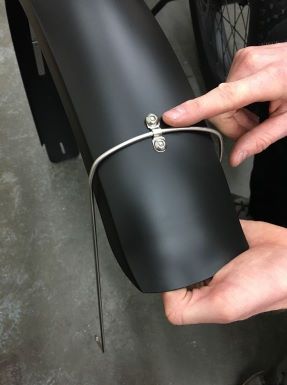
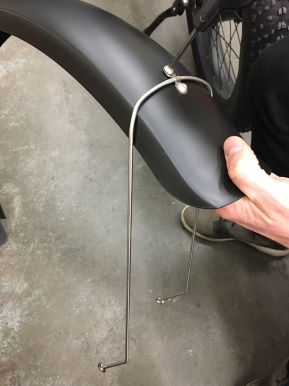
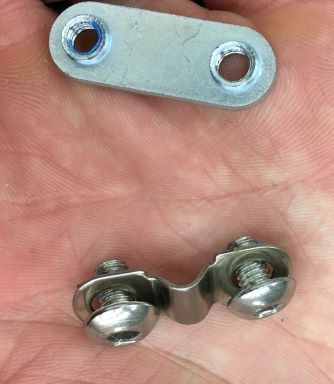
- Install the 2018 mounting bracket:
- Orient the 2018 mounting bracket so the eyelets at the end of the mounting bracket bend up towards the top of the fender.
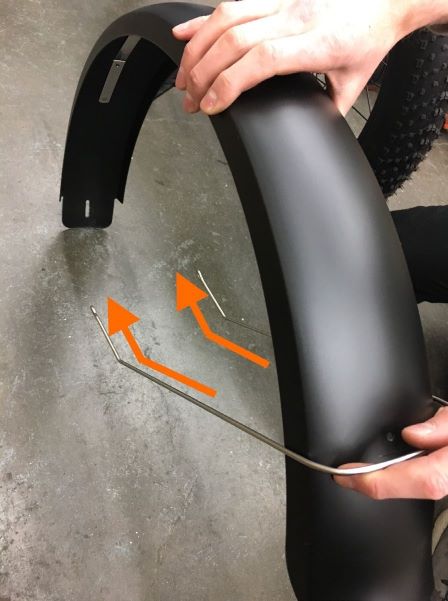
- Holding the backing plate in place on the inside of fender, place the exterior piece of the mounting bracket clamp so the holes are aligned, and the mounting bracket is centered in the clamp.
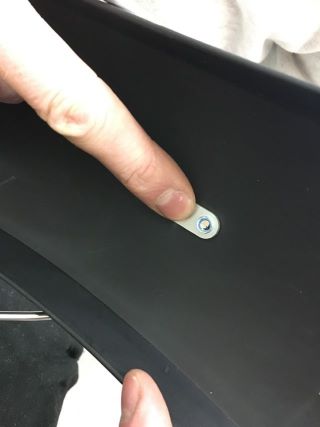
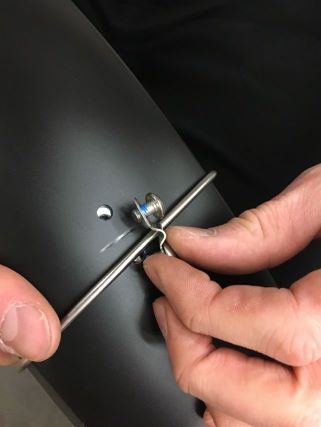
- Thread the mounting bracket clamp bolts through the exterior piece of the clamp, the fender, and into the backing plate. Tighten securely.
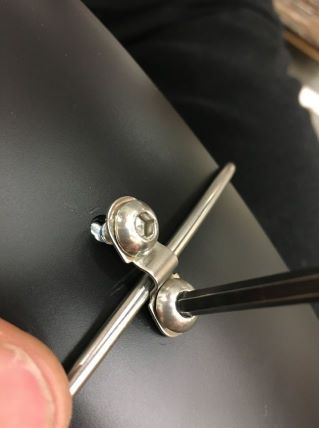
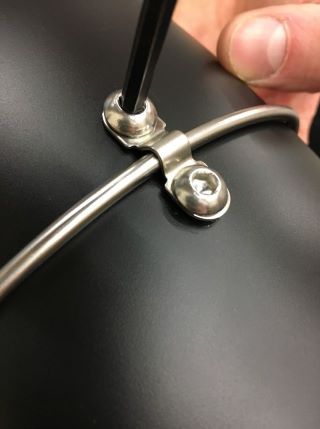
- Orient the 2018 mounting bracket so the eyelets at the end of the mounting bracket bend up towards the top of the fender.
- Remove the 2019 mounting bracket from the fender. Use a 4 mm Allen wrench to remove the two bolts holding together the mounting bracket clamp (consisting of an exterior metal piece and a threaded backing plate on the fender’s interior). Remove the 2019 bracket and recycle where possible. Set the hardware aside for re-installation.
- Deflate the rear tire OR remove the rear tire assembly following the wheel removal instructions below:
- Flip the bike upside down. Set up blocks on which the handlebar grips will rest (to prevent damage to the controls and LCD display) and flip the bike upside down resting on the handlebar grips on blocks and the seat.
- Remove the torque arm bolt. On the non-derailleur side of the wheel, use a 4 mm Allen wrench to remove the torque arm bolt, next to the axle nut, and set aside for re-installation.
- Loosen the axle nuts. Use an 18 mm wrench to loosen the axle nuts enough to allow the rear wheel assembly to be lifted out of the rear dropouts, but keep the nuts and hardware installed (the orientation of this hardware must remain the same). Set aside for re-installation.
- Unplug the motor connector. Use flat side cutters to snip the zip tie holding the motor connector cable to the frame taking care to not damage to the cable housing or wires and pull the connector directly apart without twisting.
- Remove the rear wheel. Take care to not touch the metal brake disc and lift the rear wheel assembly out of the dropouts. Note the orientation of the washers on the motor axle for re-installation. Set the wheel aside. Note: Shifting into gear 7 moves the chain down onto the smallest cog on the freewheel and will create enough slack to pull the derailleur and slide the axle out of the dropouts.
- Install the rear fender on the 2018 RadRover:
- Move the fender into position with the flared end/mounting bracket clamp near the back of the bike and the flat end near the chainstay. Deflate the rear wheel enough to align a 40 mm long bolt into the mounting point at the chainstay arch.
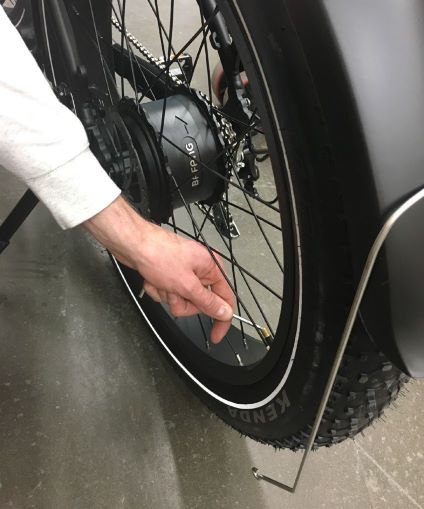
- Attach the fender at the chainstay arch. Pass one of the two 40 mm long bolts through one of the larger washers and then through the mounting point near the flat end of the fender and through the mounting point on the chainstay arch. At the back of the bolt, install another large washer and thread the lock nut onto the bolt end. Use a 5 mm Allen wrench and 10 mm wrench to tighten part way.
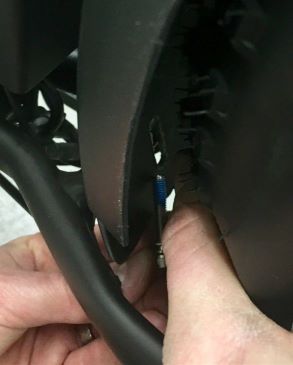
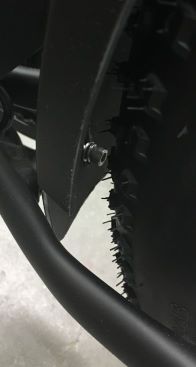
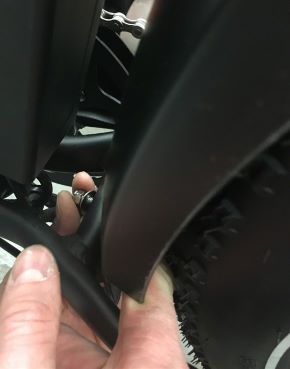
- Attach the fender at the seatstay arch. Pass the other 40 mm long bolt through into the mounting point on the seatstay arch then the U-shaped mounting bracket on the fender. Install a washer and lock nut on the bolt end. Ensure adequate clearance between the fender and tire and use a 5 mm Allen wrench to torque to 6 Nm.
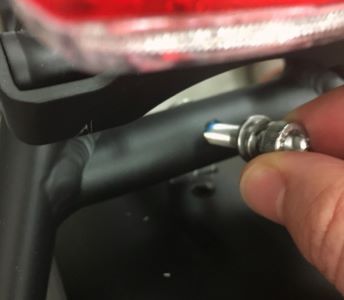
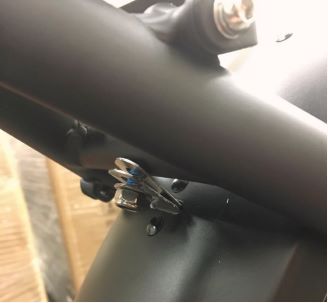
- Torque the chainstay bolt to 6 Nm.
- Move the fender into position with the flared end/mounting bracket clamp near the back of the bike and the flat end near the chainstay. Deflate the rear wheel enough to align a 40 mm long bolt into the mounting point at the chainstay arch.
- If previously removed, install the rear wheel on the 2018 RadRover:
- Move the rear wheel into position in the rear dropouts taking care to not touch the metal brake disc. Place motor washers back into their original orientation, ensure the brake disc slides in between the brake pads in the brake caliper, and the axle is fully seated in the dropouts. Note: Aligning the chain on the smallest cog of the freewheel will create enough slack to pull the derailleur back and slide the axle into place.
- Tighten the axle nuts. Ensure the axle is fully seated in the dropouts and use an 18 mm wrench to torque the axle nuts to 40 Nm. Note: leave the torque arm bolt uninstalled for now.
- Plug in the motor connector. Carefully align the pins inside the connector and arrows on the connector housing and press the two sides directly together without twisting to ensure proper connection.
- Zip tie the motor connector cable to the cable guide on the chainstay. Use flat side cutters to trim the excess zip tie
- Attach the mounting bracket to the 2018 rear dropouts:
- On the left side of the bike, take care to not touch the brake disc, and pass a 23 mm long bolt through a larger washer, the fender mounting bracket eyelet, the torque arm bolt hole, and thread the bolt into the torque arm bolt mounting point on the rear dropout. Use a 4 mm Allen wrench to torque to 5 Nm.
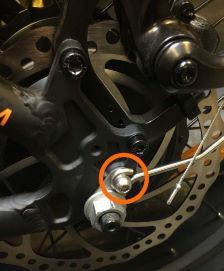
- On the right side of the bike, use a 4 mm Allen wrench to remove the bolt on the derailleur bashguard that is closest to the derailleur. Pass a 23 mm long bolt through a larger washer, the fender mounting bracket eyelet, the bashguard mounting point, and thread the bolt into the mounting point on the dropout. Use a 4 mm Allen wrench to torque to 5 Nm.
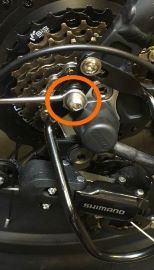
- On the left side of the bike, take care to not touch the brake disc, and pass a 23 mm long bolt through a larger washer, the fender mounting bracket eyelet, the torque arm bolt hole, and thread the bolt into the torque arm bolt mounting point on the rear dropout. Use a 4 mm Allen wrench to torque to 5 Nm.
- Reinstall the battery, test the 2018 RadRover fully, and have your work inspected by a certified, reputable bike mechanic before continuing to Ride Rad!
2019 RadRover Rear Fender Installation Steps:
- Deflate the rear tire OR remove the rear tire assembly following the wheel removal instructions below:
- Flip the bike upside down. Set up blocks on which the handlebar grips will rest (to prevent damage to the controls and LCD display) and flip the bike upside down resting the bike on the handlebar grips on blocks and the seat.
- Remove the bashguard. Use a 4 mm Allen wrench to remove the two bolts holding the derailleur bashguard. Set the bolts aside for re-installation.
- Remove the torque arm bolt. On the non-derailleur side of the wheel, use a 4 mm Allen wrench to remove the torque arm bolt, next to the axle nut, and set aside for re-installation.
- Loosen axle nuts. Use an 18 mm wrench to loosen the axle nuts enough to allow the rear wheel assembly to be lifted out of the rear dropouts and set aside for re-installation.
- Unplug the motor connector. Use flat side cutters to snip the zip tie holding the motor connector cable to the frame taking care to not damage to the cable housing or wires and pull the connector directly apart without twisting.
- Remove the rear wheel. Take care to not touch the metal brake disc and lift the rear wheel assembly out of the dropouts. Note the orientation of the washers on the motor axle for re-installation. Set the wheel aside. Note: Shifting into gear 7 moves the chain down onto the smallest cog on the freewheel and will create enough slack to pull the derailleur and slide the axle out of the dropouts.
- Install the rear fender on a 2019 RadRover:
- Move the fender into position with the flared end/mounting bracket clamp near the back of the bike and the flat end near the chainstay. Deflate the rear wheel enough to align a 40 mm long bolt into the mounting point at the chainstay arch.
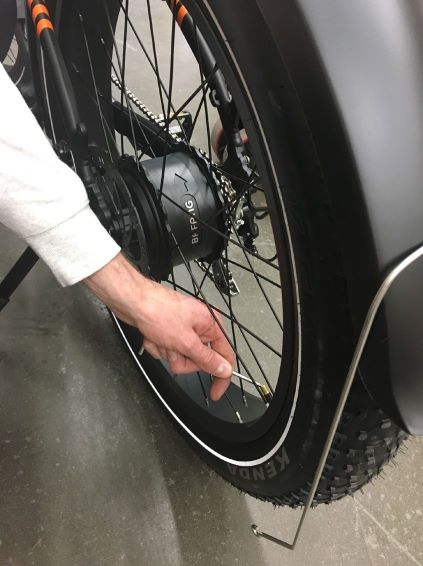
- Attach the fender at the chainstay arch. Pass one of the two 40 mm long bolts through one of the larger washers and then through the mounting point near the flat end of the fender and through the mounting point on the chainstay arch. At the back of the bolt, install another large washer and thread the lock nut onto the bolt end. Use a 5 mm Allen wrench and 10 mm wrench to tighten part way.
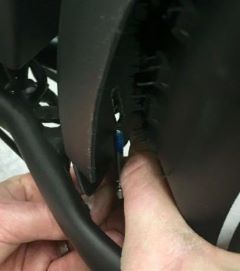
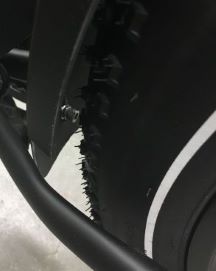
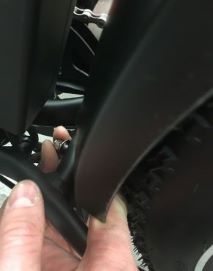
- Attach the fender at the seatstay arch. Pass the other 40 mm long bolt through into the mounting point on the seatstay arch then the U-shaped mounting bracket on the fender. Install a washer and lock nut on the bolt end. Ensure adequate clearance between the fender and tire and use a 5 mm Allen wrench to torque to 6 Nm.
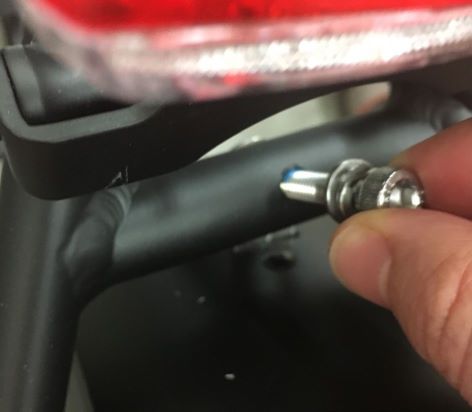
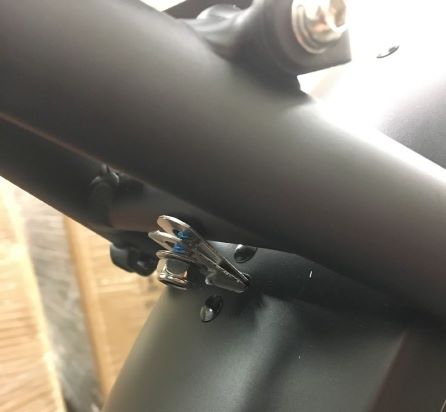
- Torque the chainstay bolt to 6 Nm.
- Move the fender into position with the flared end/mounting bracket clamp near the back of the bike and the flat end near the chainstay. Deflate the rear wheel enough to align a 40 mm long bolt into the mounting point at the chainstay arch.
- If previously removed, install the rear wheel on the 2019 RadRover:
- Move the rear wheel into position in the rear dropouts taking care to not touch the metal brake disc. Place motor washers back into their original orientation, ensure the brake disc slides in between the brake pads in the brake caliper, and the axle is fully seated in the dropouts. (Note: Aligning the chain on the smallest cog of the freewheel will create enough slack to pull the derailleur back and slide the axle into place).
- Install the torque arm bolt. On the brake disc side of the wheel, thread the torque arm bolt through the torque arm and into the mounting point on the dropout. Use a 4 mm Allen wrench and torque to 5 Nm.
- Tighten the axle nuts. Ensure the axle is fully seated in the dropouts and use an 18 mm wrench to torque the axle nuts to 40 Nm.
- Plug in the motor connector. Carefully align the pins inside the connector and arrows on the connector housing and press the two sides directly together without twisting to ensure proper connection.
- Zip tie the motor connector cable to the cable guide on the chainstay. Use flat side cutters to trim the excess zip tie.
- Attach the mounting bracket to the 2019 rear dropouts:
- On the left side of the bike, take care to not touch the brake disc, and pass a 23 mm long bolt through a larger washer, the fender mounting bracket eyelet, and thread the bolt into the mounting point farthest back on the dropout (image below, left). Use a 4 mm Allen wrench to torque to 5 Nm.
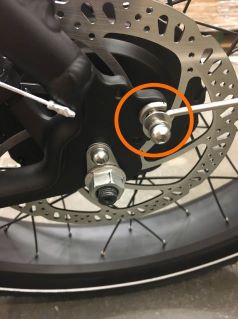
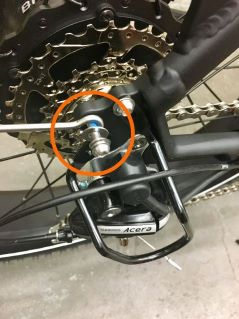
- On the right side of the bike, pass a 23 mm long bolt through a larger washer, the fender mounting bracket eyelet, and thread the bolt into the mounting point farthest back on the dropout (image above, right). Use a 4 mm Allen wrench to torque to 5 Nm.
- On the left side of the bike, take care to not touch the brake disc, and pass a 23 mm long bolt through a larger washer, the fender mounting bracket eyelet, and thread the bolt into the mounting point farthest back on the dropout (image below, left). Use a 4 mm Allen wrench to torque to 5 Nm.
- Install the taller taillight mount on the 2019 RadRover to ensure adequate light visibility:
- Remove the shorter taillight mount: Snip the zip ties holding the taillight onto the cable guides (left, below) and disconnect the taillight connector by pulling both sides directly apart without twisting (middle, below). Use a 4 mm Allen wrench to remove the two bolts holding the taillight mount to the frame (with the taillight attached). Set the hardware aside for re-installation.
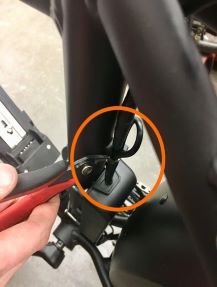
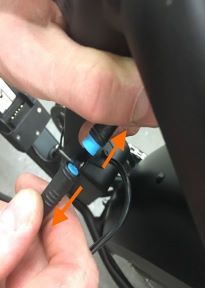
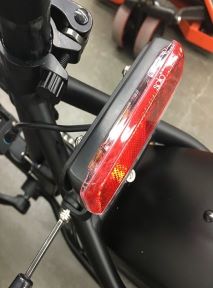
- Transfer the light to the taller mount. Use an 8 mm wrench to remove the two backing nuts and washers holding the light onto the mount. Remove the taillight from the shorter mount. Place the light into position on the light mount, with the cable passing through the hole in the back of the mount, and the mounting points pointing backwards. Place a washer onto the back of one bolt, and thread the nut onto the bolt end. Repeat on the other side and tighten both bolts securely.
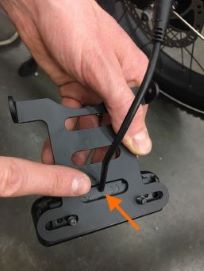
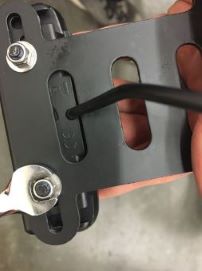
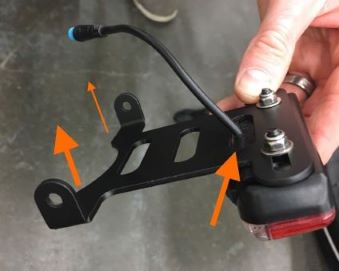
- Install the taller taillight mount. Place the light mount, with light installed, into position. Angle the light slightly back towards the seat post to ensure adequate visibility and use a 4 mm Allen wrench to bolt the taillight mount to the bike securely.
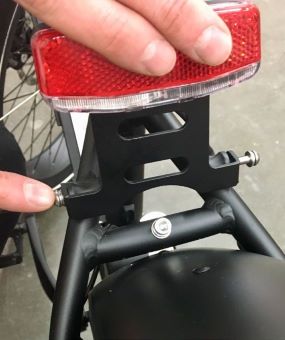
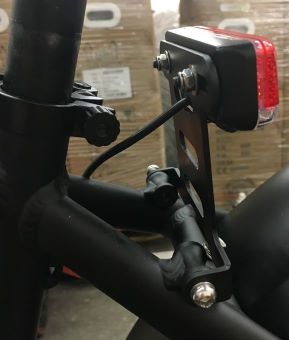
- Connect the taillight by carefully aligning the pins inside and arrows on the housing and pressing the ends together to fully seat the taillight connection. Attach the taillight cable to the cable guides using zip ties. Snip the excess zip tie ends.
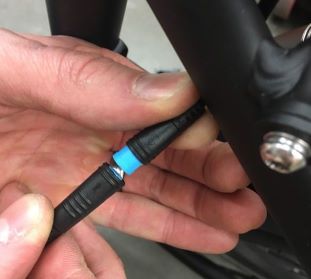
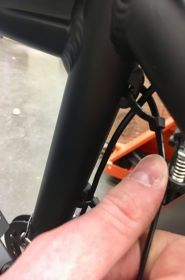
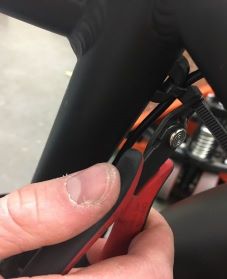
- Remove the shorter taillight mount: Snip the zip ties holding the taillight onto the cable guides (left, below) and disconnect the taillight connector by pulling both sides directly apart without twisting (middle, below). Use a 4 mm Allen wrench to remove the two bolts holding the taillight mount to the frame (with the taillight attached). Set the hardware aside for re-installation.
- Reinstall the battery and test the bike fully before riding.
